Disclosure: We may earn commissions if you purchase products after clicking on a link from our site.
Do you hunt deer during the daytime? Do you want to hunt deer at night? Hunting deer at night is similar to hunting deer during the daytime but it is slightly different. Additionally, you will have to find out if it is allowed in your state. In this article, we discuss how to hunt deer at night to help you take down more deer during the night.
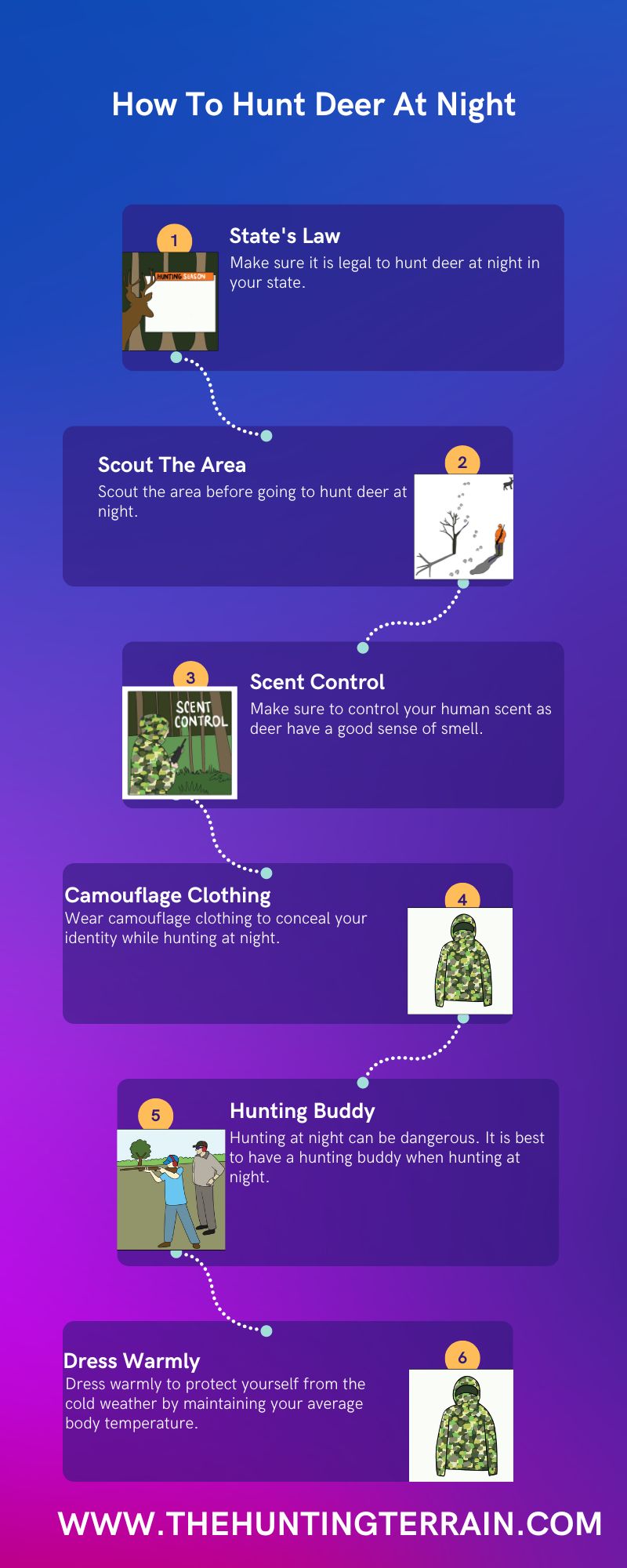
Table of Contents

How To Hunt Deer At Night
- State’s Law
Hunting deer at night is rewarding but is also very dangerous. It poses a high danger to others who may be hunting or in the area you are hunting deer at night. Additionally, hunting deer or other animals at night may not be ethical with the methods or equipment you use. Hence, not all states allow hunting at night. The first thing you need to do before you hunt deer at night is to find out if it is legal in the state you want to hunt in. You can research it online at this website.
- Scout the Area
Before you go night hunting, it is always good to scout the area. You can use Google Earth or hunting apps like HuntStand or onX to locate food sources, possible travel routes, water sources, bedding areas, transition lines, funnels, and access points to monitor the deer movement. Deer are nocturnal and you will gather more information about their movement and behavior during the night.
You can set up trail cameras to collect information about deer at night. Learn their movements and behaviors in the area and track them for quite some time before the hunting season begins. Deers have a set of routines they carry out day and night. They will continue with those routines in that area if they are not interrupted. Learn their routines and find a way to set up in a position to take advantage of their night routines.
- Scent Control
Whether you hunt deer at night or during the day, one of the important things to pay attention to is controlling your human scent. Deer have a very good sense of smell. Along with their good eyesight, their sense of smell also helps them avoid predators and danger.
A couple of days before you go hunting, “de-scent” all of the clothing you will wear. Spray them with a scent killer and store them in a scent-proof bag. Use scent-free bathing soap on the morning before the night that you are going to hunt. Use a scent-free towel and get dressed in scent-free sweat pants, socks, and a t-shirt.
Do not wear your hunting boots while driving to the hunting area. Instead, wear rubber clogs when driving and getting your gear out of the car. All of these precautions may sound too much, but it works.
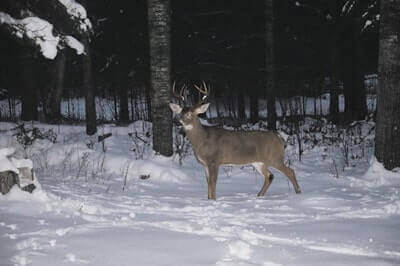
- Camouflage Clothing
These may be beaten-down words but you must wear the appropriate clothing for hunting. From scouting the area, you should have a pretty good idea of the area. Wear the right camouflage clothing that will conceal you in that area. Safety should also be taken seriously and wear any safety color to identify you to other hunters that might be hunting at night in that area.
- Hunting Buddy
It is better to have a hunting buddy when you go deer hunting at night. For safety reasons, you will be better off with a hunting companion when hunting deer at night. It is also very important that the two of you stay together when hunting at night and don’t get separated or one partner goes missing. There are dangers from wild animals as well as from other people.

- Sit Still & Be Quiet
Deer have a sense of hearing and big bucks have the ability to pick up high-frequency sounds miles away. It is very important that you remain quiet all the time you are deer hunting at night. Make sure your cell phone volume is off or the cell phone is off. If deer pick up noise in the vicinity of where you are located, it may take many hours before they come near that area. They will only come that way again after they are convinced that the danger is no longer present.
- Dress Warmly
You will need to dress warmly to protect yourself from the cold weather by maintaining your average body temperature. Avoid wearing any cotton as it absorbs moisture and it would be difficult for you to stay warm if it rains. Instead, wear synthetic or wool fabric that will retain the heat and prevent moisture absorption. Dressing in layers will help keep you warm. Additionally, it must be stated once again, that all of the clothing you will wear must be scent-free for best hunting results.

- Hunting Over Bait
Setting up a bait pile and positioning yourself with a clear line of sight to the bait pile is one way to deer hunt at night. You can also set up bait a couple of yards from the bait pile and lead the bait back to the bait pile. This method has been used effectively by many hunters but many mature bucks have come to be wary of bait piles.
They usually stay far away from the bait pile and observe the area for weeks, and maybe months for any human activity before making any movement toward the bait pile. Always verify if it is legal to set up a bait pile to hunt deer at night.
- Predator Calls
Predator calls can be used to deer hunt at night but it is not being widely used. Using predator calls will take away the “no noise” aspect of hunting in the night. Some bucks may be wary of the calls if they don’t hear calls during the night on a regular basis. This is where your scouting findings can be helpful.
If you scouted the area and heard calls from deer and remembered the times you heard them, then you can use predator calls, but it is not widely used for hunting deer at night. If you are interested in getting a predator call, then read our review of the best predator calls on the market today.
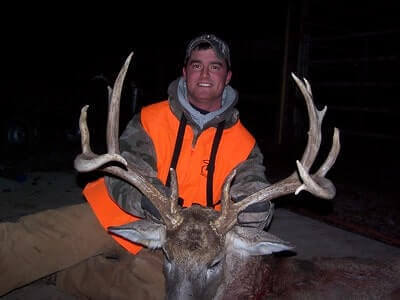
Deer Night Hunting Strategies
There are basically two strategies for hunting deer at night. They stand hunting and stalking the deer.
- Stand Hunting
Stand hunting involves patiently waiting for the deer to come in your direction while standing, or sitting. It is a popular hunting method used by many hunters, especially when you hunt in open terrain. With stand hunting, you have to locate the pathway of the deer and wait for it to come. You can use a ground blind or a treestand to implement stand hunting. Reviews of the best hunting ground blinds and the best climbing treestands can be read through these links.
- Stalking the Deer
After spotting a deer you will have to move very quietly and follow the deer until you can get a good shot. With stalking the deer, you will have to have to know the terrain very well and avoid noise as much as possible. Stalking the deer is very hard to implement during the night as deer have better night vision and can easily detect movement.

Items For Hunting Deer At Night
- Night Vision Binoculars
Night vision binoculars are an invaluable tool for hunting deer at night, offering hunters the ability to see in low-light conditions with remarkable clarity and detail. These advanced optical devices utilize cutting-edge technology to amplify ambient light, including moonlight and starlight, to provide enhanced visibility in darkness.
With the ability to magnify distant objects, hunters can survey their surroundings and spot deer with precision even in the darkest of nights. Equipped with infrared illuminators, night vision binoculars can further enhance visibility in complete darkness, allowing hunters to detect elusive game animals without alerting them with bright lights.
Whether scanning vast open fields or navigating through dense forests, night vision binoculars provide hunters with a distinct advantage, enabling them to track and pursue deer under the cover of darkness with confidence and accuracy. A review of the best night vision binoculars can be found at this link.
- Thermal Scopes
Thermal scopes can also be used to identify deer when you hunt at night, but you must be sure that it is legal to use them to hunt deer at night. Thermal scopes are essential tools for hunting deer at night, offering hunters unparalleled visibility in complete darkness.
Unlike traditional night vision devices, thermal scopes detect heat signatures emitted by objects, including animals, regardless of lighting conditions. This advanced technology allows hunters to spot deer and other game animals even in dense foliage or obscured by darkness, making it ideal for nocturnal hunting expeditions.
Thermal scopes provide clear, high-resolution images of the surrounding environment, enabling hunters to track deer with precision and accuracy. With features such as customizable reticles and zoom capabilities, hunters can easily identify targets and make accurate shots, ensuring ethical and successful hunts even in challenging nighttime conditions.
Thermal scopes are invaluable assets for hunters seeking to extend their hunting opportunities into the nocturnal hours while maintaining the highest standards of safety and ethical hunting practices.
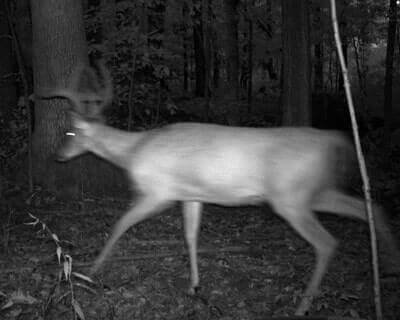
- Spotlights
Spotlights can also help you while hunting deer at night and also verify that it is legal to use them. Spotlights are indispensable tools for hunting deer at night, providing hunters with powerful illumination to scan the surrounding area and locate game.
Equipped with high-intensity bulbs or LEDs, spotlights cast a bright beam of light over long distances, piercing through darkness and revealing the presence of deer in the nocturnal landscape. Hunters can use spotlights to sweep through fields, woodlands, and other hunting grounds, effectively spotting deer hiding in shadows or dense vegetation.
Spotlights with adjustable focus and beam width allow for precise targeting and tracking of deer, enabling hunters to identify potential targets with clarity and confidence. Additionally, some spotlights feature colored filters or adjustable brightness settings, providing versatility for different hunting conditions and preferences.
When used responsibly and in compliance with local hunting regulations, spotlights enhance visibility and safety for nocturnal hunting expeditions, contributing to successful and ethical deer hunting experiences.
- Compass
Always carry a fully functioning compass with you when you go hunting especially when you hunt at night. While a compass may not be a direct tool for hunting deer at night, it is an essential navigational aid that can be invaluable for ensuring a safe and successful nighttime hunting expedition.
When hunting in unfamiliar or remote areas, especially during low-light conditions, it’s easy for hunters to become disoriented or lose their sense of direction. A compass provides a reliable means of determining cardinal directions, allowing hunters to navigate through the terrain with confidence and accuracy.
By using a compass in conjunction with a map or GPS device, hunters can plot their routes, mark key locations such as hunting stands or game trails, and effectively track their movements during nighttime deer hunting excursions.
Additionally, in the event of unexpected circumstances such as getting lost or disoriented in the darkness, a compass can be a lifesaving tool for finding one’s bearings and safely returning to familiar territory. Therefore, while not directly related to deer hunting itself, a compass is an essential item for night hunters to ensure they can navigate the terrain effectively and make the most of their hunting experiences.
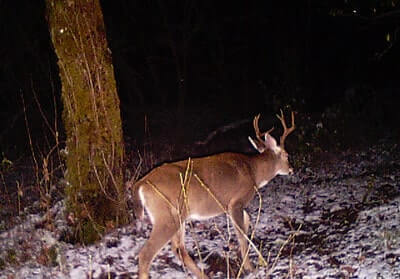
- Flashlights
A high-powered, pencil-thin flashlight is always good to take along with you when you hunt at night. Flashlights are indispensable tools for hunters venturing into the darkness to pursue deer at night. Equipped with powerful beams of light, these devices illuminate the hunter’s path, allowing them to navigate through rugged terrain and dense vegetation with ease.
Beyond aiding in navigation, flashlights are essential for spotting signs of deer activity such as tracks, droppings, or rubs, which may otherwise go unnoticed in the darkness. Moreover, when the moment of truth arrives and a deer is sighted, a flashlight can help hunters accurately assess the target and take precise aim, ensuring ethical and effective shots.
Additionally, should the need arise to track a wounded deer after the shot, a flashlight becomes invaluable for following blood trails and locating the animal. Modern advancements in flashlight technology, such as LED bulbs and adjustable brightness settings, offer hunters versatile options tailored to their specific needs, whether it’s preserving battery life for extended hunts or casting a powerful beam over long distances.
In essence, flashlights are indispensable companions for nocturnal deer hunters, providing illumination, safety, and the means to make well-informed decisions in the dark wilderness.
- Trail Cameras
Trail cameras can be set up in the area you want to hunt and collect information on the movement and behaviors of deer in the area. Trail cameras serve as invaluable assets for hunters seeking to monitor deer activity, especially during the cover of night.
These motion-activated devices are strategically placed in key locations, such as game trails or feeding areas, to capture images or videos of passing deer. Equipped with infrared or low-glow technology, trail cameras can operate discreetly without alerting deer to their presence, making them ideal for nocturnal observation.
By reviewing the captured footage, hunters can gain valuable insights into deer behavior, movement patterns, and preferred feeding times, helping them better understand the quarry’s habits and increase their chances of success. Furthermore, trail cameras provide hunters with the ability to remotely monitor hunting grounds, allowing them to identify trophy bucks or target specific individuals for harvest.
With features like adjustable trigger speeds, high-resolution images, and long battery life, trail cameras offer hunters a versatile and reliable tool for nighttime deer hunting, enhancing their ability to scout, strategize, and ultimately achieve their hunting goals. If you want to read a review of the best trail cameras on the market today, click this link.
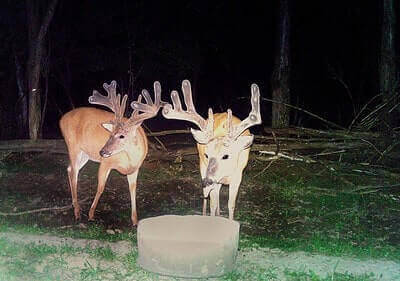
- Green Lights
Green lights can also help you while hunting deer during the night. However, it may cause the deer to move away from where you may be located. Green lights have become popular among hunters for nocturnal activities, including hunting deer at night. These specialized lights emit a green wavelength that is less likely to spook deer compared to traditional white lights.
The use of green lights allows hunters to illuminate their surroundings without startling or alarming the deer they are pursuing. Green lights are particularly effective for scanning the woods, tracking blood trails, or navigating through dense vegetation in low-light conditions.
Additionally, green lights can enhance visibility without affecting the natural behavior of deer, making them an essential tool for hunters looking to maintain stealth and minimize disturbance during nighttime hunts. Whether mounted on a headlamp, rifle, or handheld device, green lights provide hunters with a practical and efficient solution for safely and effectively hunting deer after dark.
- Laser Sights
Laser sights can also be used to hunt deer at night but may cause the deer to move away from your area. Laser sights are valuable tools for hunters venturing into the darkness to pursue deer. These devices emit a focused beam of light that can be precisely directed onto the target, providing shooters with a clear aiming point even in low-light conditions.
When hunting deer at night, where visibility may be limited, laser sights offer enhanced accuracy and confidence in shot placement. By projecting a visible laser dot onto the target, hunters can quickly acquire their aim and ensure precise shots, especially in situations where traditional sights may be difficult to use effectively.
Additionally, laser sights can be particularly advantageous for tracking wounded deer or navigating through dense foliage during nighttime hunts. Whether mounted on a rifle, handgun, or crossbow, laser sights provide hunters with an added level of precision and control, making them a valuable asset for successful nocturnal deer hunting endeavors.

The Bottom Line
Deer hunting at night has become popular in the last few decades. Not many states allow hunting deer at night but there are a few that do. It is exciting and rewarding as it is dangerous. Hunting deer at night is similar to deer hunting during the daytime except you have to factor in the darkness and plan for it. In this article, we discuss how to hunt deer at night to help beginners and more experienced deer hunters be more successful when they hunt deer at night.
If you are interested in hunting gps, then this review of the best hunting gps is a good read. Attracting deer to your bait pile using deer attractants is an effective strategy. if you are interested in deer attractants, read a review of the best deer attractants. You can also read how to hunt, how to plan a hunting trip out of state, how to field dress a deer, and how to hunt deer on public land.